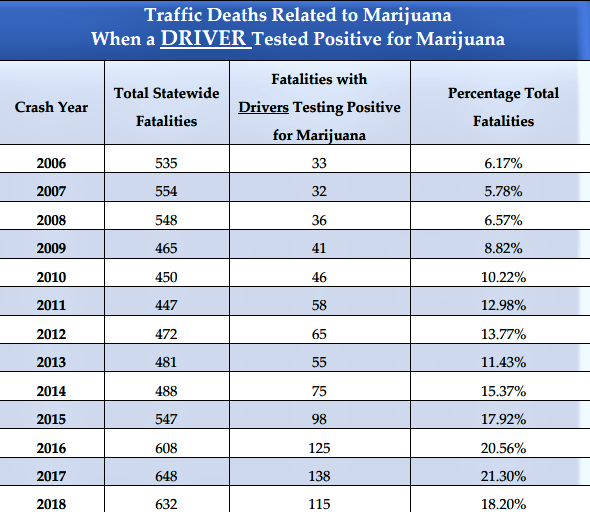
Pam Dudding
Contributing writer
Marijuana is often referred to as pot, CBD, grass, weed and reefer. Regardless of name, there are more and more studies being conducted that suggest that the plants’ positive uses are becoming increasingly narrower and more questionable.
The Rocky Mountain High-Intensity Drug Trafficking Area (RMHIDTA) Program has published annual reports every year since 2013 tracking the impact of legalizing recreational marijuana in Colorado.
They share their information with other states and the Blue Ridge Behavioral Healthcare feels the information and statistics are also being seen in surrounding counties throughout Virginia.
Their core purpose is to provide data and information so that policymakers and citizens can make informed decisions on the issue of marijuana legalization.
They have made many comparisons and intense studies in many areas:
- Traffic Fatalities & Impaired Driving
- Since recreational marijuana was legalized, traffic deaths in which drivers tested positive for marijuana increased 109 percent while all Colorado traffic deaths increased 31 percent
- Since recreational marijuana was legalized, traffic deaths involving drivers who tested positive for marijuana more than doubled from 55 in 2013 to 115 people killed in 2018. (This equates to one person killed every 3 days in 2018 compared to one person killed every 6 ½ days in 2013.)
- Since recreational marijuana was legalized, the percentage of all Colorado traffic deaths that were marijuana related increased from 15 percent in 2013 to 23 percent in 2018
- Marijuana use since recreational marijuana was legalized
- Past month marijuana use for ages 12 and older increased 58 percent and is 78 percent higher than the national average, currently ranked fourth in the nation
- Adult marijuana use increased 94 percent and is 96 percent higher than the national average, currently ranked fourth in the nation
- College-age marijuana use increased 18 percent and is 48 percent higher than the national average, currently ranked sixth in the nation
- Youth marijuana use decreased 14 percent and is 40 percent higher than the national average, currently ranked sixth in the nation
- Public Health
- The yearly number of emergency department visits related to marijuana increased 54 percent after the legalization of recreational marijuana (2013 compared to 2017)
- The yearly number of marijuana-related hospitalizations increased 101 percent after the legalization of recreational marijuana (2013 compared to 2017)
- Marijuana only exposures more than quadrupled in the six-year average (2013-2018) since recreational marijuana was legalized compared to the six-year average (2007-2012) prior to legalization
- The percent of suicide incidents in which toxicology results were positive for marijuana has increased from 14 percent in 2013 to 23 percent in 2017
- Black Market
- RMHIDTA Colorado Drug Task Forces conducted 257 investigations of black-market marijuana in Colorado resulting in: 192 felony arrests, 6.08 tons of marijuana seized, 60,091 marijuana plants seized and 25 different states the marijuana was destined
- Seizures of Colorado marijuana in the U.S. mail system has increased 1,042 percent from an average of 52 parcels (2009-2012) to an average of 594 parcels (2013-2017) during the time recreational marijuana has been legal
- Societal Impact
- Marijuana tax revenue represents approximately nine-tenths of one percent of Colorado’s FY 2018 budget. 64 percent of local jurisdictions in Colorado have banned medical and recreational marijuana businesses
A huge concern that has opened the eyes to many counselors was in the “Protecting Virginia’s Youth Rocky Mountain HIDTA Report” in 2019, it stated, “Children’s unintentional exposure to marijuana has increased and can lead to hospitalizations.”
Additionally, from 2018 to 2019, daily use of marijuana increased 26.3 percent among 8th, 10th and 12th graders 43 percent of college students used marijuana at least once in the past year, the highest amount since 1983.
“Considerable evidence suggests that students who smoke marijuana have poorer educational outcomes than their nonsmoking peers,” according to those who conducted the report. They suggested that vaping marijuana has increased since 2017. THC can be as high as 99 percent when vaped.
The reports also find that:
- When young people quit using marijuana, they are at a lower risk of developing cognitive impairment or mental health issues than those that continue using marijuana
- Regular use (daily/near-daily use) by young people can be associated with the development of schizophrenia and other psychotic disorders in adulthood
- People who begin using marijuana before the age of 18 are four to seven times more likely to develop a marijuana use disorder
- Evidence suggests that exposure to marijuana during teen development can cause “long-term or possibly permanent adverse changes to the brain”
For more information, one may search, Marijuana – youth consequences Teen and Young Adult Marijuana Use Source: https://rmhidta.org/files/D2DF/FINAL-Volume6.pdf
The goal of RMHIDTA is to assist other states and facilities in exposing the effects of marijuana as quickly as possible to prevent long term damage to children and adults as well, by providing in-depth studies.



